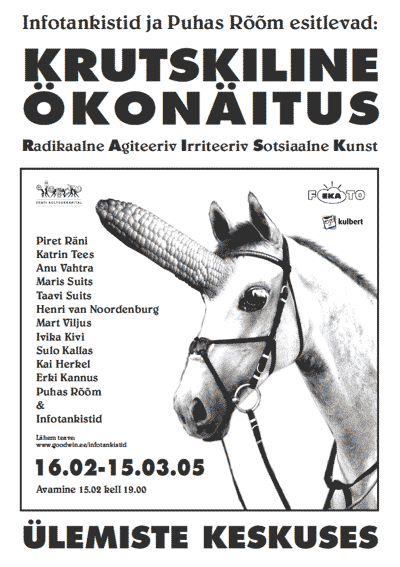|
||||
The best of Estonian social art – eco-art exhibition R.A.I.S.K. R.A.I.S.K. (Radikaalne Agiteeriv Intrigeeriv Sotsiaalne Kunst or Radical, Agitating, Intriguing Social Art) at the Library of the University of Tartu, January 17 to February 13, 2005, and in the first floor box at Ülemiste shopping mall, February 16 to March 15, 2005. Participants:the Infotankers, Sheer Joy, Piret Räni, Katrin Tees, Anu Vahtra, Maris Suits, Taavi Suits, Mart Viljus, Kai Herkel, Henri van Noordenburg (Australia), Erki Kannus, Ivika Kivi and Sulo Kallas. This exhibition encompasses the ecological concerns on a wider scale; values that predispose overconsumption and future scenarios are under scutiny here. Contamination of the mental environment gives the artists as much food for thought as the pollution of nature. The name of the exhibition is a play of words that needs to be explained, though – the word "raisk" in Estonian means both "spoilage, waste" as well as "carrion, carcass", and is also a common "medium strength" expletive – not exactly a dirty word, but not one used in polite conversation. The aim of the exhibition is to bring to public eye the deficiencies in the ambient social environment and the self-devouring nature of the consumerist world view. It is within the powers of every human being to elongate the potential age of the Earth; maybe not that much, but still somewhat. If we all limit consumption, presrve nature, refrain from throwing our garbage in the woods, etc, there might be a chance for our children's children to see the Sun and take a walk in the forest.
|
||||
The name R.A.I.S.K. is derived mainly from the terms "to waste" and "to go to waste" that combine the social dimension in with the ecological world view – the concept encompasses both the waste of natural resources as well as overconsupmption, both the overpolluted values as well as the lives gone to waste because of lack of caring. In addition to the ecological meaning there is concern over wasted (life)time. An average person can manage around 60 to 90 years, if lucky; this is not a long time and the world is crammed with so many interesting things. But how much of what any of us have done during the span of our lives can we look back on with content as on something meaningful or needful for oneself or others? |
Our aim – the aim of the Infotankers, Sheer Joy and thei adherents – is to spread care for life and living environment. We want to better the world by making the audience think and by offering solutions and a reason for a small laugh. We don't like waste in the ecosystem; even less are we fond of the waste inside people's heads. Through our works we hope to manage a small "spring cleaning" in the minds of the audience, i.e. to help them find the bigger kind of garbage – harmful thoughts that are hostile towards humans and nature. |
| Artworks: | ||
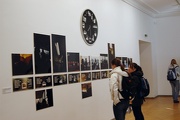
|
Ajaraisk |
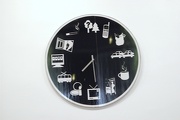 |
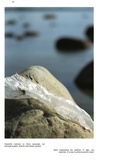 |
Litterer's Handbook. Advanced Level Risustaja käsiraamat
edasijõudnutele |
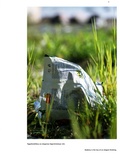 |
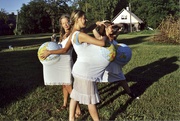 |
Global
Preagnancy I Puhas Rõõm, 2002 |
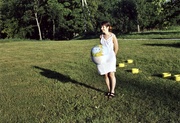 |
 |
Loomade elu |
 |
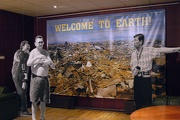 |
Welcome
to Earth! Infotankistid, 2005 |
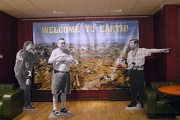 |
 |
Karikatuurid |
 |
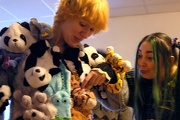 |
Meie karvased sõbrad |
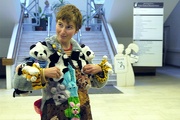 |
 |
Eesti meeste kaitseala |
 |
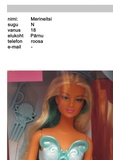 |
Vali-mind.jee |
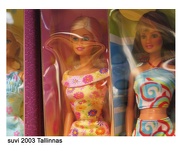 |
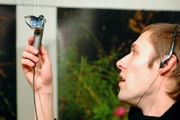 |
Loodusharmoonia aseaine |
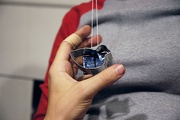 |
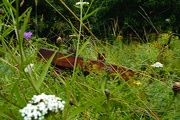 |
The Independent Life Of Machines Masinate iseseisev elu |
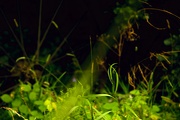 |
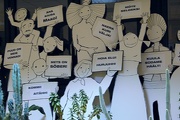 |
Meeleavaldus |
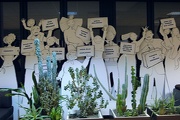 |
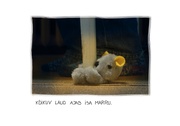 |
Mänguloomade
väärkohtlemine |
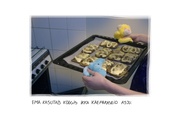 |
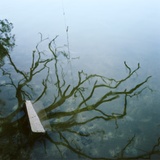 |
Offer
or Offence Henri van Noordenburg, Austraalia |
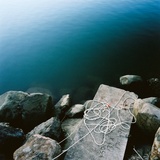 |
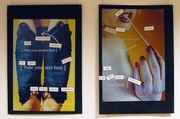 |
Agentuur Keha Müüb! |
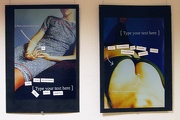 |
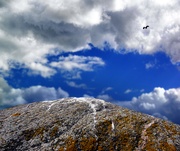 |
Albid |
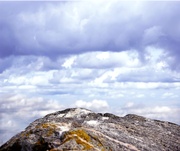 |
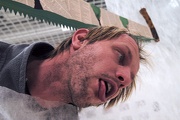 |
Roosa ja roheline |
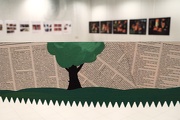 |
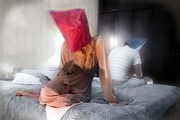 |
Infotankistid, 2004 |
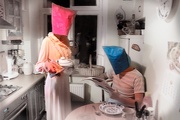 |
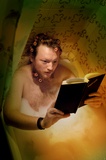 |
Infotankistid, 2004 |
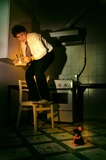 |
The Infotankers, Katrin Tees, Piret Räni, Erki Kannus and a visiting artist from Australia, Henri van Noordenburg are expanding on their concern over the world by exploring the pollution of ecological environment. The huge photo-installation "Welcome to Earth" by Infotankers shows a possible future scenario – the whole world has turned into a dumping ground; one can see nothing but junkscape, all the way to the horizon. In front of the photographic wallpaper with a pretty view of the garbage dump stand the Tourists, whose task is to remind the exhibition-goers that they are living on this very planet, not just visiting briefly for sightseeing. Another project contemplating the theme of pollution so inherent to this eco-exhibition has grappled the task with rare sharp irony. In her humorous were-publication "Litterer's Handbook. Advanced Level" Katrin Tees teaches us how, according to the best Feng Shui traditions and the canons of internal decoration, garbage should be laid out in the nature in order to achieve the most enjoyable results. Parallel to the discourse of the Infotankers, Piret Räni's triptych "The Alps" (again, the Estonian name is a play of words; "Albid", seemingly a misspelling of the Alps, actually means "the fatuous, the inept, the silly"), wherein stone peaks covered in bird droppings have due to photographic editing acquired the dimensions of a chain of mountains. Again we are reminded of tourism booklets; again, at the moment of recognition, the word "waste" rings in the ears of the viewer, but this time the irony is aimed at the sense of beauty as well as facade-manipulation. The biggest concern for Estonian nature preservationists is predatory lumbering of forests. Erki Kannnus's heartache over this is embodied in the object "Pink And Green" – a two-man saw covered in a business newspaper. Business adverts form a background to a painted forest... With a humane grin, the eco-portion is drawn to a conclusion by the documentation of the performance "Global Pregnancy" by Sheer Joy, wherein world-pregnant young women are calling on us to regard our home planet as we would regard our own children – as a blood relative that must be cared for and looked after. The projects "Waste Of Time", "pick-me.yeah", "Body Sells" and "Reservation Of Estonian Men" are addressing the waste in people's heads, that means, the social side of our lives. The photo-based mural "Waste Of Time" by the Infotankers painstakingly outlines to the viewers all the wasted hours that "a resident of Tallinn" or "an Estonian woman" has spent during a year, whether standing around in vehicles of public transportation, waiting in a traffic jam, playing solitaire in a computer-induced stupor or gorging down soap operas from television. And these numbers are staggering. The aim of the piece is to remind the viewers that life is short and one won't get back the time once wasted. Also, "Waste Of Time" speaks of alienation – the last block in the mural claims that a resident of Tallinn spends only 20 hours a year in natutral environment. But he or she is submerged in commercial content for 1465 hours a year – that embraces the whole multi-coloured barrage of advertsiments seething in the streets as well as in newspapers, in radio as well as the television. In turn, the composition "Agency: Body Sells!" by Anu Vahtra and Maris Suits shows how the wishes, cravings and gender-role-based behaviour of consumers are consciously and unconsciously molded by advertising. |
This fictional advertising agency produces
universal poster-bases depicting the figures of young women as well
as well as small word-bricks with sure-to-sell vocabulary that the viewer
can use right on the spot for a personalised advertisment. "Pick-me.yeah" by Katrin Tees is a humorous commentary to the million-user-website rate.ee (Estonia only has a population of a million), where without a shadow of hesitation people display themselves as merchandise for others to rate. The composition encompasses authentic text from the web portal, found by the author and definitely not mirroring the supposed higher-than-average level of education of Estonians. The photo series "Reservation Of Estonian Men" by Piret Räni shows a species endangered in Estonian society – moustached men drinking in the countryside beside their tattered old Soviet car. Is the government, on the backdrop of americanization, actually willing/able to offer us any alternatives? The touching ground of ecological as well as social problems is probed by different authors in a surprisingly similar way, through lifeless animals – toys, stuffed wild animals and electronic birds. The coat made of toys by the Infotankers called "Our Furry Friends" and the photo series “Abuse Of Toy Animals” by an artist couple Maris & Taavi Suits are drawing parallels between toys and living creatures and tell of respect and care towards anything living. The coat sewn together from the "skins" of furry toys is the most pretentious and effective showpiece of the exhibition – dozens of pairs of eyes confronting viewers make them yell out "Awww, how cute!" and damn the artists to the seventh pit of hell. But at the same time, a message is brought home – seeing a coat made out of real animal skins the same people will not be ooh-aahing or expressing schock caused by their anthropomorphic assumptions. Are our values lopsided when lifeless objects make us more compassionate than actual living animals. "The Life Of Animals" by Mart Viljus gives ample room for semiotic analysis. The picture-language of these manipulated photographs contain parallels with the paradise pictures from "The Watchtower", where all the animals and men are singing and dancing together in a friendly manner. With the help of media used as a real document, i.e. presented as a photo, the forced association of the animals screams out in especially sharp notes. Predators are placed side by side with rodents, which goes against logic, and the viewer doesn't know anymore whether to fear an attack rather from the rabbit than from the wolf. At the same time, it is a bizarre and appalling apocalyptic nature park, where human hand has arranged the animals in "proper" positions, in order to see them whenever it strikes a fancy, in just the way one likes them. The installation "Surrogate To Natural Harmony" by Ivika Kivi and Sulo Kallas may make one contemplate possible visions of future. Environment-wise the solar-battery-powered tweeting birds are supported by Kai Herkel's photos from the serias "The Independent Life Of Machines". In one hand, this is a suggestion to produce artificial Nature. The sounds of the birds actually create a meditative soundscape that, when listened to with eyes closed, brings to mind a summer field filled with the buzz of insects, which means that resting in such a room might have a therapeutic and calming effect; at the same time such a rest area would be easy to maintain. Surrogate Nature has become a product – is this good or bad? On the other hand, the piece of art is an homage to Sun that has given life to the complex evolutionary processes on our home planet, in the same way that it's giving life to these robotic birds. Piret Räni |
| For further information: Piret Räni – 58058806, pir.rani@mail.ee |
